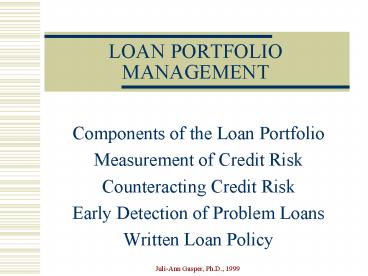LOAN PORTFOLIO MANAGEMENT PowerPoint PPT Presentation
1 / 17
Title: LOAN PORTFOLIO MANAGEMENT
1
LOAN PORTFOLIO MANAGEMENT
- Components of the Loan Portfolio
- Measurement of Credit Risk
- Counteracting Credit Risk
- Early Detection of Problem Loans
- Written Loan Policy
2
Components of the Loan Portfolio
- Commercial and Industrial Loans
- Real Estate Loans
- Consumer Loans and Credit Cards
- Broker Call Loans and Interbank Loans
3
The Return on a Loan
- Stated Interest Rate, Compounding Period,
Frequency of Repricing - Fees
- Credit Risk Premium
- Collateral Backing of the Loan
- Non-price items (Compensating Balances, Reserve
Requirements)
4
Measurement of Credit Risk
- Quantitative Models
- Credit scoring models
- Linear probability models
- Logit and Probit models
- Multiple Discriminant analysis models
- Option models
- Qualitative Models
- Borrower-specific factors
- Reputation
- Leverage
- Volatility of Earnings
- Collateral
- Market factors
- Business cycle
- Interest rates
5
Credit Scoring
- General Concept
- Use observed borrower characteristics
- Estimate probability of default OR
- Sort borrowers into risk classes
- What do you accomplish by doing this?
- Identify factors explaining default risk and
their importance - Improve pricing of risk
- Screen out bad apps
- Calculate reserves
6
Linear Probability Models
- Uses past info as inputs into a model to
statistically explain past defaults, creating a
regression equation - where ?j is the weight for the jth
variable - Derive a Z for ith borrower that is the
probability of default
7
Multiple Discriminant Models
- Divide borrowers into 2 classeshigh risk of
default vs. low risk of default - Use past data to develop the equation for a
sample of those who defaulted and a sample of
those who didnt - Create the discriminant boundary between the two
groups - Place new apps in one group or the other
8
Discriminant Score Distribution
Zone of Ignorance
No default
Default
- predicted
- predicted
FREQUENCY DISTRIBUTION OF Z SCORES using past
data of known defaulting loans
9
Option Models--Payoff to Borrower (Stockholders)
Payoff to stockholders
0 A1
Debt A2 Assets
10
Option Models--Payoff to Debtholder/Lender (Bank)
Payoff to debtholders
0 A1
Debt A2 Assets
11
Counteracting Credit Risk
12
PORTFOLIO DIVERSIFICATION
CORRECT LOAN PRICING
- FI makes loans with less than perfect correlation
- Difficult to apply portfolio theory in case of
individual loans - Can partially do it with national databases of
loans--use info to set portfolio allocations to
different segments of borrowers
13
PORTFOLIO DIVERSIFICATION
EARLY DETECTION SYSTEMS
CORRECT LOAN PRICING
- Requires judgement of default risk and portfolio
effects - Can include non-price items in protective
covenants - Choice of variable vs. fixed interest rates
- Default risk, interest rate risk, operating
expenses all need to be included in loan pricing
14
EARLY DETECTION SYSTEMS
CORRECT LOAN PRICING
- Monitor the value of collateral assets
- Use monitoring technology to gather and
evaluate info on continuous basis - Identify problem loans and create workout
strategies early
15
WARNING SIGNS
- Financial
- standard financial analysis of performance
- Operational
- production, inventory management
- relationships with suppliers, distributors, etc.
- physical appearance of the premises
- Banking
- declining balances
- frequent loan requests
- slow payments
- Managerial
- personal and business habits
- risk-taking attitudes
- day-to-day involvement
- turnover
16
CREDIT CULTUREImportance of a Written Loan Policy
- CREDIT CULTURE
- Organizational design
- Reporting arrangements amongst loan officers
- Communication practices
- Incentive schemes for loan officers
17
WRITTEN LOAN POLICY
- General policies
- Specific loan category policies
- Miscellaneous loan policies
- Quality control policies
- Committees

